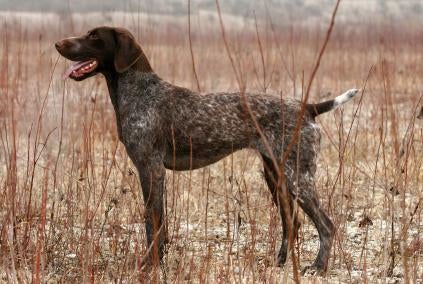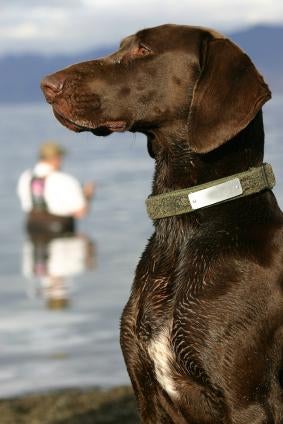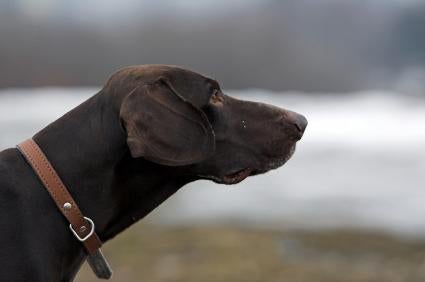German Shorthaired Pointer Training & Breed Information
With a sleek, athletic body and a unique dappled coat, the German shorthaired pointer is an instantly recognizable breed. Wonderful both as family and hunting dogs, this breed has an ancient and rich background, and is a worthwhile study for anyone thinking about getting a dog.

[google_ad:DOTR_CMS_468x60_InArticle1]
History Of The German Shorthaired Pointer
The earliest dog that the German shorthaired pointer can be traced to is the Spanish pointer, which was introduced in Germany at some point in the 1600's. From this breed the Germans wanted to create a dog that was excellent at both pointing and retrieving and could traverse land and sea.They were really aiming to create an all-purpose hunting machine. It is not entirely known what breeds were mixed with the Spanish pointer to achieve the German shorthaired pointer of today, but it is thought that the foxhound, schweisshund, German bird dog, English pointer, and several Scandinavian breeds were mixed along the way to create the breed. It was in the 19th century that German shorthaired pointers were truly refined, with the first stud book being created in 1870.
One of the driving forces behind the shaping of the breed was Prince Albrecht zu Solms-Brounfield of the Royal House of Hanover, who encouraged breeders to breed for function rather than form.
German Shorthaired Pointer Appearance
The German shorthaired pointer is a medium sized dog of about 21 to 25 inches in height, and weighing about 55 to 70 pounds. The females tend to be a bit smaller than males in most cases. GSP's are athletic and should appear streamlined, with powerful hind muscles that aid in quick pursuit or sudden turns during a hunt. To aid in swimming, the breed also has webbed feet. Shorthaired pointers have long, straight muzzles, and high set, broad ears that flop over close to the head. It is also very common to have a shorthaired pointer's tail docked, though this is now illegal in some countries.
To aid in swimming, the breed also has webbed feet. Shorthaired pointers have long, straight muzzles, and high set, broad ears that flop over close to the head. It is also very common to have a shorthaired pointer's tail docked, though this is now illegal in some countries.
One of the most interesting things about a German shorthaired pointer's appearance is its coat, which is dense and sleek, and also comes in many interesting colors. A dark brown color, often identified as "liver" is quite common, as is black, though a black coat disqualifies a dog from showing in the AKC. These colors are often accompanied by white spots, sometimes in large amounts, other times in a mottled appearance that is known as "ticking". A very common color variation is a dog whose whole front half is liver, followed by ticking on the hindquarters and extremities. The German shorthaired pointer's coat is also extremely functional, having a dense undercoat topped with stiff guard hairs which are water repellant and seal in warmth. Overall this breed not only has a uniquely beautiful appearance, but also an extremely functional one as well.
The All Important GSP Temperament
Not only does a German shorthaired pointer make a good hunting partner, the breed also makes an excellent family dog. Any individual of the breed should be intelligent, bold, affectionate, cooperative, and easily trained.Shorthaired pointers also love children, but there is one caveat. German shorthaired pointers are not dogs meant for apartment dwellers or couch potatoes, they are an active working breed that requires a lot of exercise and training. While they love children and are affectionate companions, the breed is also quite boisterous and needs to work off energy on a regular basis. Playing fetch, agility training, hiking, and swimming are all great ways to work with a shorthaired pointer if they are not to be used as a hunting dog. If this breed is not trained well and exercised regularly they can become quite destructive, simply out of sheer boredom.
It is also important to have a fenced yard for shorthaired pointers, because they will exercise their hunting instincts on common animals like squirrels. Once a shorthaired pointer is set on the trail it can be hard to recall them unless they are very well trained - and losing a dog can be heartbreaking.
[google_ad:DOTR_CMS_468x60_InArticle2]German Shorthaired Pointer Health Issues
Perhaps one of the byproducts of Prince Albrecht's encouragement to breed for function rather than form is that the German shorthaired pointer has few serious health concerns. Overall they are a very healthy and robust breed. Like any purebred dog though, they do have their issues.Because the shorthaired pointer's nose is long and thin, the nasal passages can become constricted and cause the dog to gag and have difficulty breathing. Another issue that can rear its head is hip dysplasia, which can cause painful arthritis and eventually lameness. Congenital eye defects can also be a problem.
When selecting your German Shorthaired Pointer breeder you should ask about these health issues and whether or not either of the parents has shown any signs of these genetic defects. A good GSP breeder will be happy to discuss the health of the parents and show any health records or DNA tests he or she may have.
One final health concern for German shorthaired pointers is the unexplained enlarging of the nipples, even in male dogs. This is normal for the breed, and most of the time is harmless. If the nipples are bleeding or there is discharge though, the dog should be taken to the vet, because these things can be a sign of cancer.
Caring for a German shorthaired pointer is very easy. They don't need daily brushing like long haired breeds, and only need baths occasionally. Like any breed with flop ears they need to have their ears regularly checked and cleaned to prevent ear infections. Shorthaired pointers also require a fair amount of high quality food as a working breed, though they need to be exercised in order to avoid obesity. If taken care of properly a German Shorthaired Pointer will be your friend for 12 to 14 years, which is their normal lifespan.
Training A German Short hair Pointer
As mentioned earlier the German Shorthaired Pointer is very intelligent and takes to training with great enthusiasm and skill.All the basic obedience training commands (sit, stay, down, come...) are picked up easily by GSP's. Be sure to use positive reward based training methods with your Pointer - they certainly don't require (or enjoy) any forceful methods based on intimidation and fear.
A couple of training issues you will want to get right with a German Shorthaired Pointer are the "come" command (they love to wander off at the dog park!) and how to walk nicely while on leash. Pointers are very strong so you don't want to get involved in a tug of war with your dog while on leash - no one wins in such a game.

German Shepherd Pointer Dog Breed Profile - My Conclusion
If you are looking for a sweet, energetic, and very smart dog, a German Shorthaired Pointer would be an excellent choice. Consider how well this breed would fit into your family, not just today, but for the next twelve years. If you decide that a shorthaired pointer is going to be a great addition to your family, congratulations!Remember to also consider adoption, as well as buying from a reputable German Shorthaired Pointer breeder (never buy from a pet store). Good luck with your new friend, and may you bring many years of joy to each other.
Please consult the services of a Professional Dog Trainer, Behaviorist or Veterinarian before implementing any of the advice contained on this site.










